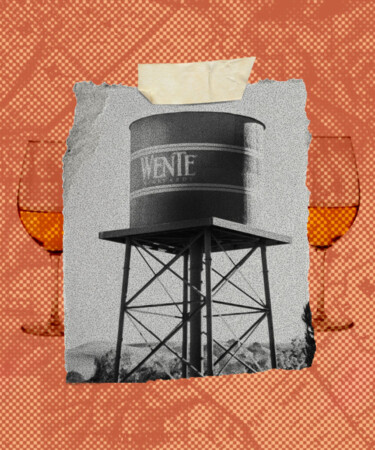The Wente family is credited with many firsts, including being America’s “First Family of Chardonnay” after Ernest Wente introduced Chardonnay to America in 1912 when he planted it at the Gier Vineyard in Pleasanton, Calif. Today, the vast majority of all California Chardonnay stems from the Wente clone and the Wente family property. Lesser known, though, is how Wente Vineyards is also responsible for preserving domestic Sauvignon Blanc and facilitating its growth across the globe.
“I’ve always been interested in bringing the family lore into reality,” says the vineyard’s vice-chairman and fourth-generation winegrower Phil Wente. It was he who discovered records in the family archives that illuminated the larger impact they’ve had on Sauvignon Blanc’s resilience.
In 1884, Sauvignon Blanc was planted in the U.S. for the first time. Cuttings from Château d’Yquem — the hallowed Bordeaux estate known for producing the most prized Sauternes — were planted at the Livermore Valley estate of French emigrant Louis Mel. Prohibition would have all but sealed the fate of that Sauvignon Blanc just a few decades later in the 1920s, which was then in the process of being removed and replaced with thick-skinned grapes useful for home winemaking. The Wente family became instrumental in its preservation, as they continued to purchase grapes from Mel’s property throughout the 1920s and 1930s, while maintaining their own plantings to make sacramental wines for Beaulieu.
In 1932, Wente Bros. produced and released the country’s first varietally labeled Sauvignon Blanc, Semillon, and Chardonnay (then known as Pinot Chardonnay). Up until this time, most American wine drinkers didn’t understand specific grape varieties, and wines were often mislabeled with French designations. And due to rampant corruption within the California Wine Association, the body responsible for promoting the interests of California wine grape growers, wine buyers were kept in the dark about what was really in their bottles.
“Back then it was the Wild West,” Wente says of the early 20th century . “The federal government didn’t have enough employees to monitor truth in labeling. The California Wine Association bought nearly all of the wine, blended it and sold it under labels and brands that they could successfully market.”
At the time, the Wente family was one of few California winemakers bottling their own wines. Their trailblazing decision to pioneer varietal labeling immediately upon Prohibition’s repeal ensured a continued and growing demand for the grape. The Wente family ultimately acquired the property on which the original Sauvignon Blanc vines were grown in 1940, ensuring their long-term survival.
“We always focused on enhancing the health and intensity of the fruit with each new vineyard and we developed a reputation for the finest-tasting Chardonnay and Sauvignon Blanc in California,” Wente says. “So when people wanted to plant vineyards again after Prohibition, they would come to us for the budwood.”
Fast-forward to 1958, when Dr. Harold Olmo, professor of viticulture and enology at the University of California, Davis, collected the plant material for this selection from the Wente Vineyards in Livermore. At UC Davis, the material was treated to kill any viruses and eventually named Sauvignon Blanc FPS 01, or Sauvignon Blanc #1, and released as certified clean stock safe for planting around the world. This same clone is perhaps best known as the foundation for the extreme success of Sauvignon Blanc in New Zealand, where the same clone is known as UCD 1. Today, the majority of Sauvignon Blanc from New Zealand, Australia, Chile, and South Africa remains based on the original Wente Sauvignon Blanc #1 clone.
At Wente Vineyards, these pedigreed vines are still grown in Louis Mel’s original vineyard plot, located across the windswept arroyo. Now named for Louis Mel, the Wente Vineyards’ Sauvignon Blanc and its complexity can be traced to its prestigious French heritage as well as its unique Livermore Valley terroir. Of course, the wine itself has evolved over the years, reflecting the changing tastes of wine consumers. For example, the estate has shifted its harvesting strategy when it comes to Brix, or the measurement of sugar content levels in grapes that dictates alcohol content in finished wines.
“My grandfather used to love to pick Sauvignon Blanc when it was about 21 Brix,” Wente says. “Now we pick it around 23.5 Brix. At 21 Brix it had a more herbal character, and now it has more of a grapefruit character. Those style changes have occurred over the years and I think palates have changed. Our view of the consumer is that they like a little more body and texture in wine.”
Their newest limited-release Sauvignon Blanc is fermented and aged in neutral French oak barrels rather than stainless steel tanks, for a deeper, rounder flavor and slightly higher alcohol content.
“Winemakers love to experiment with small lots,” Wente says. “They get to be more artistic, and we don’t necessarily need to take it to the market in a big way, but our club members love trying new things. And if they love it, then maybe we can consider expanding that style.”
Thanks to the Wentes, the future of Sauvignon Blanc is bright, and winemakers around the world can continue to experiment with different styles, techniques, and terroir for this popular grape.
